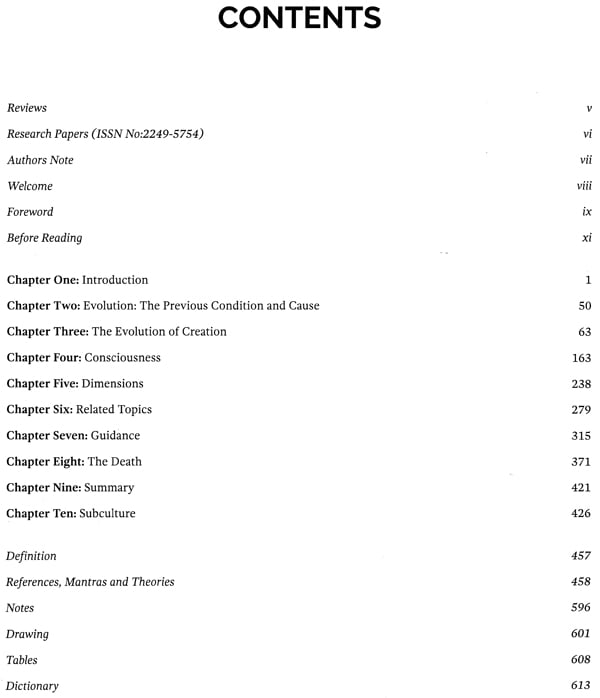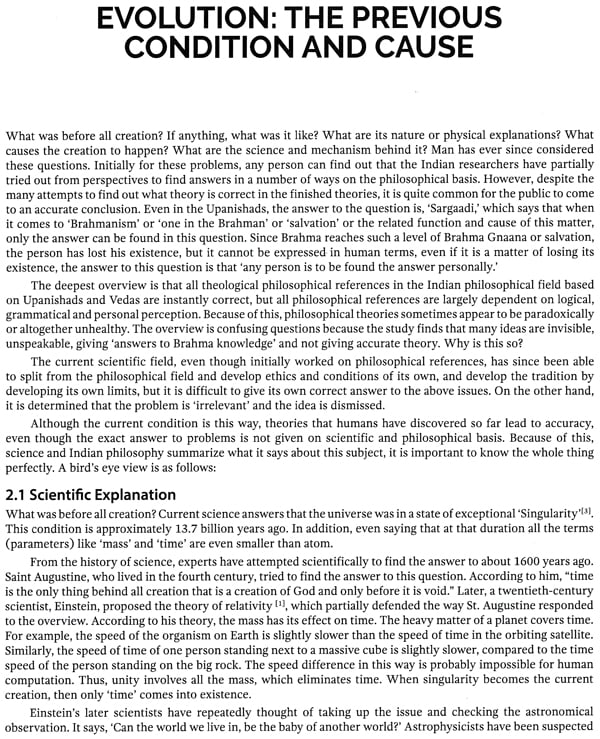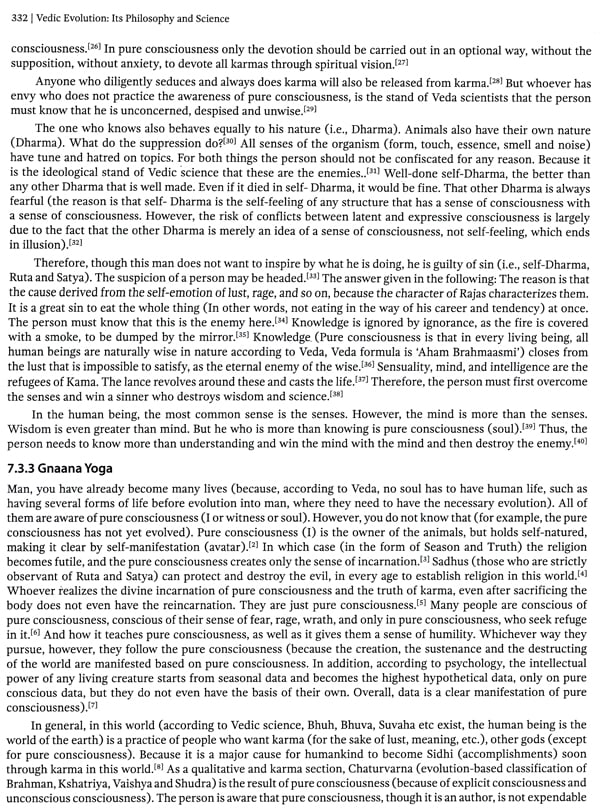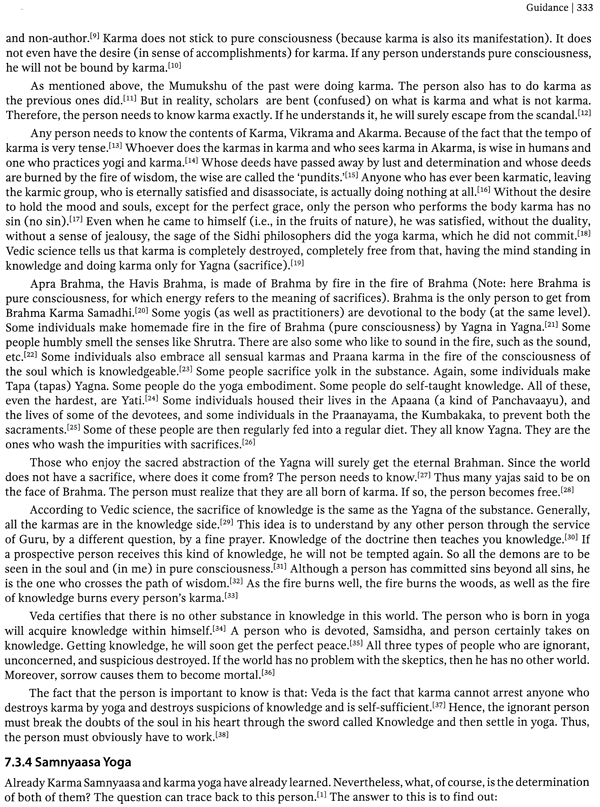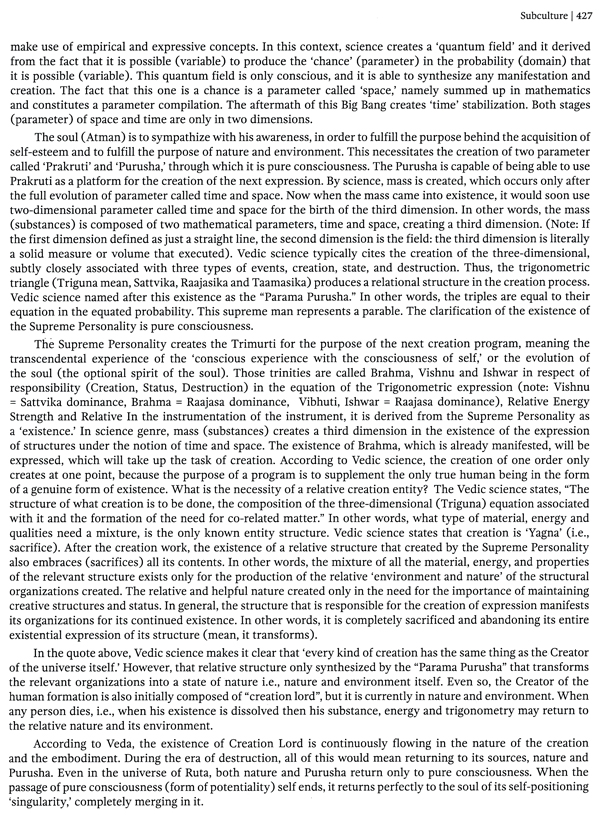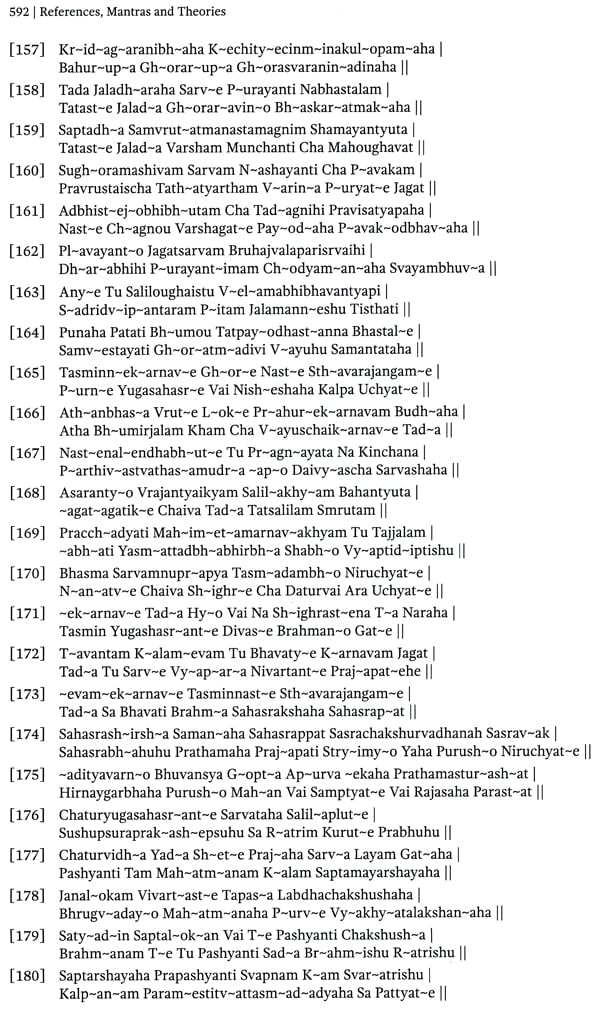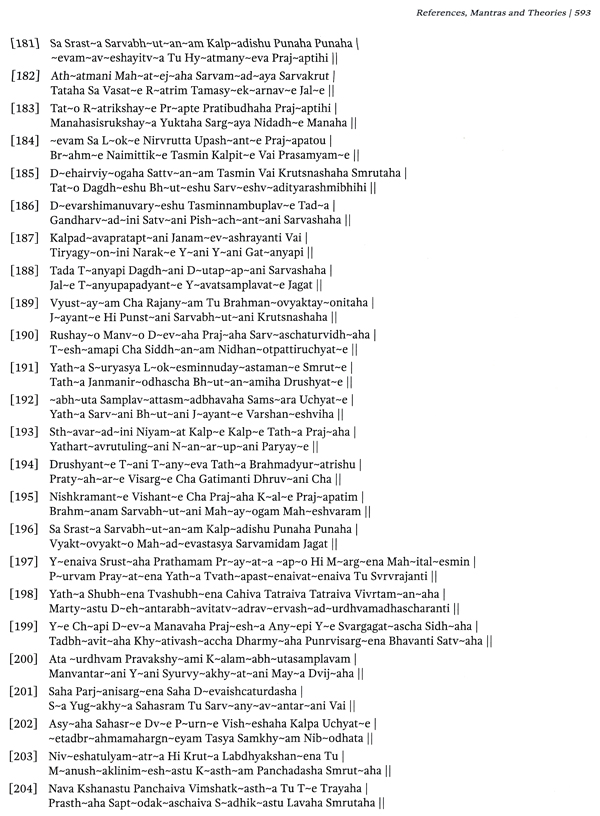
Vedic Evolution (Its Philosophy and Science)
Book Specification
| Item Code: | NAS091 |
| Author: | Chandra Moulims |
| Publisher: | Notion Press |
| Language: | English |
| Edition: | 2018 |
| ISBN: | 9781644295243 |
| Pages: | 652 |
| Cover: | PAPERBACK |
| Other Details | 11.00 X 8.50 inch |
| Weight | 1.41 kg |
Book Description
It is important for any person to examine the existing rational sections prepared at logical and theoretical levels, in order to overhaul the physical, psychological and subtle layers of historical evolutionary attitudes and conditions, future actions and its mechanical, technical and philosophical aspects. The rational sections are mainly Veda, Upanishad, Philosophy, Darshanas, Puraana, Science and Psychology.
In particular, Vedic, Upanishad, Philosophy, Darshanas, Mythology, Science and Psychology have discussed evolutionary history of evolution. Science has evidently discussed the evolution and evolutionary history of many evidences, as well as Indian history, philosophy and mythological references, not only about the history of evolution, but also on present-day situations, aspects of future and understanding, and implementation. For all these reasons, the following is an introductory bird view of the relevant sections of evolution.
1.1 Vedic Division
`Veda' is from the `Dhaatu' called, `Vid.' There is a meaning of Vid, knowing. `Vid-Jnaane' means, the understanding of knowledge. It also called as `Vaangmaya.' Veda is a religious literature that is archetypal, perhaps the oldest of the findings. Its literature viewed as' recordings of intellectual references based on many individuals' endeavors' benefits. Its references called Prookta.' In other words, Veda references not made in the human intellectual thinking base, but primarily creates pre-synthesis in the human language medium. The experts say `Kartaara' (author) of the references as `Drastaara.' (Note: Drastaara mean viewers; who looked at the sight). Moreover, the Vedas also called Apourusheeya; In other words, it is not from any human endeavor, but in the beginning of the beginning, in the creation of the creation, and after all destructions.
The Vedas are about descriptions of life and non-life, in the formation of the scientific basis, especially the levels of human formation and evolution. In other words, the knowledge of Vaidika can also be understood by studies as `Itihaasa' (history). The word history originates from 'eti..hoo..asa; Vedas can also consider a 'historical record.' Itihaasa' has a definition in Sanskrit, the detail follows:
Itihaasa is a guide to man's evolutionary path through specific-behavioral policies. It is also a guide to achieving Dharma meaning, lust, and salvation, as the life of manifestation evolved into humanity is the primary requirement of the four necessities. Current quotes on the Vedas conceptualized, from the very beginning of creation, to the evolution of nebulae, planetary stars, land and humans. With this, it also narrates about how far evolution can achieve. The language of the Vedas is in Sanskrit as the oldest Vedic Sanskrit. There is the opinion that Veda was primarily the only one in accordance with the use of the Yagna. These identified as `Trayi' in the times of `Manusmriti.' The researchers conclude that the Rig-Veda, the Yajur-Veda and the Saama-Vedas were the only ones that had joined the Atharva-Veda during the time of Kautilya.
The Vedas have based on the culture traditionally taught by their Guru, without the help of any script. Thus, they also have the name `Shruti.' The main aim of the Vedas is to formulate a relation to the survival, meaning of life and evolution of the living organisms as 'Mantra Brahmanaatmakoo Veda.' Thus, 'these are the eternal and unquestionable wisdom,' the opinion of the people. There is a reference to Anantha Wai Vedaha,' which says 'Vedas are infinite.' Its primitive form is very high. According to the linguist Patanjali, there are twenty-one branches in Rig-Veda, one hundred branches in Yajur-Veda, one thousand branches in Saama-Veda and nine branches at Atharva Veda. Nevertheless, the current available Veda is a small part of the form. The researchers believe that 'Krishna Dwapaayana' then divided these into four divisions in the twenty-eighth Dwaapara era.
Dr. Sarvepalli Radhakrishnan, the original editor of the philosophy of the book 'Philosophy: The East and the Western,' has divided the mantras in the Vedas into four main categories. They are exactly like this: Yagna Related: (1) Rishi: Poems to recite, (2) Saman: Songs worthy of singing, and (3) Yajas: Proverb word communities; (4) Mantra: The first and third forms related to the Classical etymology even though there is no formality. If sorrows relate to climax, marriage, anointing, ghost karma, etc., relate to the rituals.
The Vedas are as follows: Yagna is mainly responsible for the Brahma, the Hootru (holder), the Adhwaryu and the Udgaatru. If the Hootru utters the mantras that praise the god, the Udgaatru must mention the mantras. Similarly, the aptitude requires the implementation of the limbs and subunits in the Yagna to carry out the responsibility of maintaining the procedure. He who holds the responsibility of Brahman's position also needs to entrust with the supervision of the Homa, the Adhwaryu and the Udgaatru. The role of 'Brahma' in Yagna is of utmost importance. He should essentially have the knowledge of Vedic branch, Atharva. Likewise, he also needs to have a rich understanding of the remaining Vedic branches. If the Hootru of Yagna is aware of the Rig-Veda, Yajur-Veda and the Adhwaryu have to knowledge of Saama-Veda.
The Vedic divisions of the Rig-Veda, Yajur-Veda, Saama-Veda and Atharva-Veda have the sacraments of the Samhita, Brahmana, Aranyaka and Upanishad. When a group of mantras is a code, the details of the implementation order of Yagna or Brahma or Brahman. Similarly, those who study in the forest are the Aranyaka, and the details of spiritual matters are Upanishad. The details of the concepts of spiritual mystery and the relativity of their related metaphorical layers, and in the Aranyaka explained in detail about the action of the Vaanaprastha, one of the Prastha Traditions. The code, Brahman and the Aranyaka are primarily discerning karma because they are called 'Karma Kaanda,' while the Upanishads discern the knowledge of them, as they are called `Gnaana Kaanda' (consciences). Upanishads are also known as 'Vedanta.' The researcher's opinion is that if the Samhita portion of the Vedas is the oldest, the Upanishads are the most recent. The Vedas have six types of organs. These six components are respectively, Shiksha, Kalpa, Nirukta, Jyotisha, Vyaakarana and Chanda. If the wise people call the Shiksha as a formal provision of the Vedas' articulation, he is called the `Kalpa' as part of the formal provision of ideas related to the sacrifices. Likewise, the discrediting of the words referred to in the Vedas, called `Nirukta,' is called mantra Vyaakarana and Chandas. In total, the study may realize that the Vedaanga, the pronunciation of Vedas, the interpretation methods are designed for experimentation. The reference to this topic can be found in the' Mundaka Upanishad' (Mantra: 1.1.5). [2] A brief view of the Vedas is as follows:
Shiksha: Shaastra is the discipline that tells the positioning patterns of 'A' kaara etc., Varna. This science also tells us how to pronounce sounds and colors. When chanting the Veda every word to pronounce with its `Swara.' The Swara are three, respectively, Udaatta, Anudaatta and Swarita. `Uchirudaatta' means, in the upper stages, is called `Udaatta' (noble). `Neechirundadah' means Anudaatta' (worthy) to say in the lower stages. To say between these two is Swarita.' The Udaatta is listed on the letters and the Anudaatta under the letters in the Vedas. Only then should we chant that Swara. The difference is meaningful when pronounced differently. Shiksha Shaastra is found in the book "Pratishakshaye." These are only formulas. Panini Shiksha, Naradishkha, Vyasishshaksha teaches texts, Vedaanga-related pedagogy. The study is subject to several advisory related formulas in the field of discipline. Vedic science says, 'without mantra kills the action, killing Rutwik in vain, therefore, Shiksha Shaastra is very important.[3] According to a reference to the Panini Shiksha script, chanting Veda in melody, uttering letters, pronouncing words with perfect differences, chanting with a beautiful voice, boldly chanting, and rhythmically, are the qualities of the speaker, Veda mantras. [4] Some references to this topic are as follows: The chanter does not chant Veda as a song. Do not chant too fast. The head should not shake. Should not read like a book. He should not chant Mantra just by lip shaking. Do not chant too slowly. Without understanding the meaning, the chanter may stop in-between which may lead to disasters, thus understanding the meaning is very much necessary. It should not be chanted in a very small chord. Thus, it is necessary to recite the Vedas and Mantras well.
Grammar: The definition of the meaning of the words of Veda is derived from grammar. `Vakirante Shabda Anena Iti Vyakaranam,' grammatical help is essential. According to this relative reference, the grammar is called the Vrushabha (ox), and all the desires; the four legs - Naama (name), Aakyata (the precept), Upasarga (the preposition) and Nipaata (the abstraction); Three feet - past, present, and future; Two heads - Supp and Tijgna; Seven Hands - Prathama, Dwitiya, Trutiya, Chaturthi, Panchami, Shasthi and Saptami Vibhakti (Nuclear); These are bound by three places, Ursus (chest), kantha (throat) and Shiras (head). Veda refers to the `Mahaa Deeva' (Great God), which enters humans. Today it is in the form of a sign.t61 The Nirukta (Mantra: 1.15) says, grammar knowledge is necessary to interpret mantras, according to the subject matter. `Katshukka' has also said that 'if Vedic mantras are not understood, it is in vain.'[7] Grammar is largely in the form of formula, created by many pundits. Particularly, Panini, in the year 700, refers to these formulas in the book `Ashtadhyayi.'
**Contents and Sample Pages**
